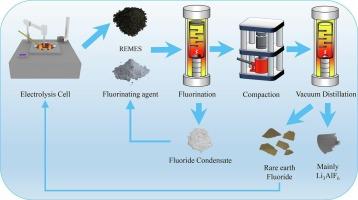The recovery of valuable elements from rare earth molten salt electrolytic slag by the fluorination-vacuum distillation method
IF 9.2
2区 工程技术
Q1 ENERGY & FUELS
引用次数: 0
Abstract
Rare earth molten salt electrolytic slag is a valuable secondary resource rich in rare earth elements, lithium and fluorine. Current recovery methods can achieve the comprehensive resource recovery and manageable costs. However, some drawbacks still need to be handled, such as excessive wastewater generation and prolonged processing times. Aiming to address these limitations, a fluorination-vacuum distillation method was proposed for recovering rare earth molten salt electrolytic slag. Initially, ammonium bifluoride was applied to fluorinate rare earth molten salt electrolytic slag at 773 K for 1.5 h, converting rare earth oxyfluorides and rare earth oxides into rare earth fluorides. The fluorinated slag was then compacted and distilled in a vacuum furnace, yielding two condensates: rare earth fluorides and a mixture of lithium fluoride and lithium cryolite. Under the optimal conditions, including distillation temperature of 1573 K, distillation time of 4 h and absolute pressure of 1 Pa, the recovery efficiencies of rare earth elements, lithium and aluminum reached 96.33 %, 99.99 % and 98.24 %, respectively. In this study, comprehensive resource recovery was achieved with a short process, and almost no wastewater or gas emission was generated due to the vacuum distillation method.

用氟化真空精馏法从稀土熔盐电解渣中回收有价元素
稀土熔盐电解渣是一种富含稀土元素、锂和氟的宝贵二次资源。现有的回收方法可以实现资源的全面回收和成本的可控。然而,仍有一些缺点需要解决,例如产生过多的废水和延长处理时间。针对这些局限性,提出了氟化真空精馏法回收稀土熔盐电渣。首先,将二氟化铵应用于稀土熔盐电解渣在773 K下氟化1.5 h,将稀土氟化氧和稀土氧化物转化为稀土氟化物。然后将氟化渣压实并在真空炉中蒸馏,产生两种凝析物:稀土氟化物和氟化锂和冰晶石锂的混合物。在精馏温度为1573 K、精馏时间为4 h、绝对压力为1 Pa的最佳条件下,稀土、锂和铝的回收率分别达到96.33%、99.99%和98.24%。本研究以较短的过程实现了资源的综合回收,真空蒸馏法几乎不产生废水和气体排放。
本文章由计算机程序翻译,如有差异,请以英文原文为准。
求助全文
约1分钟内获得全文
求助全文
来源期刊

Sustainable Materials and Technologies
Energy-Renewable Energy, Sustainability and the Environment
CiteScore
13.40
自引率
4.20%
发文量
158
审稿时长
45 days
期刊介绍:
Sustainable Materials and Technologies (SM&T), an international, cross-disciplinary, fully open access journal published by Elsevier, focuses on original full-length research articles and reviews. It covers applied or fundamental science of nano-, micro-, meso-, and macro-scale aspects of materials and technologies for sustainable development. SM&T gives special attention to contributions that bridge the knowledge gap between materials and system designs.
 求助内容:
求助内容: 应助结果提醒方式:
应助结果提醒方式:


